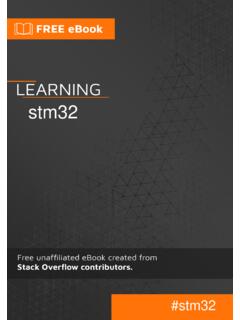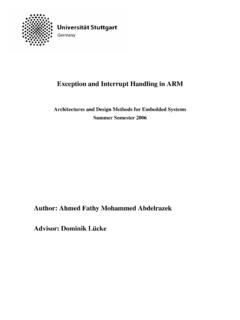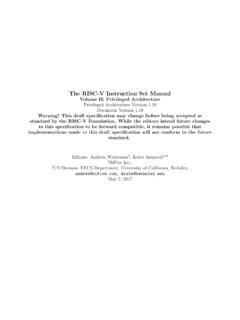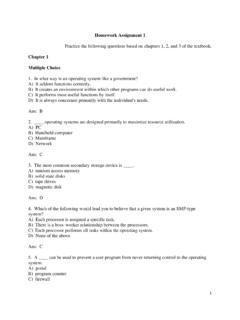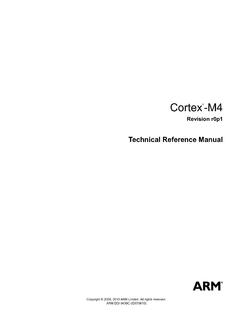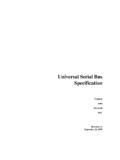Transcription of arduino
1 arduino #arduinoTable of ContentsAbout1 chapter 1: Getting started with arduino2 Remarks2 What is arduino ?2 Why Use arduino ?2 Versions2 Examples2 Bare Minimum2 Blink3 First Time Setup4 Setup5 Upload7 Serial monitor7 LED - With Button control7 chapter 2: Analog Inputs9 Syntax9 Remarks9 Examples9 Print out an Analog Value9 Get Voltage From Analog Pin9 chapter 3: arduino IDE11 Examples11 Installing on Windows11 Portable app on Windows11 Installing on Fedora11 Installing on Ubuntu11 Installing on macOS11 chapter 4: Audio Output12 Parameters12 Examples12 Basic Note Outputs12 chapter 5: Bluetooth Communication13 Parameters13 Remarks14 Examples14 Basic bluetooth hello world14 chapter 6: Data Storage15 Examples15cardInfo15SD card datalogger17SD card file dump18SD card basic file example19 Listfiles20SD card read/write22 chapter 7: Digital Inputs24 Syntax24 Parameters24 Remarks24 Examples24 Pushbutton reading24 chapter 8: Digital Output26 Syntax26 Examples26 Write to pin26 chapter 9.
2 Functions27 Remarks27 Examples27 Create simple function27 Call a function27 chapter 10: Hardware pins29 Examples29 arduino Uno R329 chapter 11: How Python integrates with arduino Uno32 Syntax32 Parameters32 Remarks32 Examples32 First serial communication between arduino and Python32 chapter 12: How to store variables in EEPROM and use them for permanent storage34 Syntax34 Parameters34 Remarks34 Examples34 Store a variable in EEPROM and then retrieve it and print to screen34 chapter 13: I2C Communication36 Introduction36 Examples36 Multiple slaves36 chapter 14: Interrupts39 Syntax39 Parameters39 Remarks39 Examples39 Interrupt on Button Press39 chapter 15: Libraries41 Introduction41 Examples41 Installing libraries with the Library Manager41 Including libraries in your 16: Liquid Crystal Library44 Introduction44 Syntax44 Parameters44 Examples44 Basic Usage44 chapter 17: Loops46 Syntax46 Remarks46 Examples46 While46 For47Do.
3 While47 Flow Control48 chapter 18: MIDI Communication49 Introduction49 Examples49 MIDI THRU Example49 MIDI Thru with Queue49 MIDI Clock Generation51 MIDI Messages Defined52 chapter 19: PWM - Pulse Width Modulation57 Examples57 Control a DC motor through the Serial port using PWM57 The basics57 Bill of materials: what do you need to build this example58 The build58 The code58 PWM with a TLC594059 chapter 20: Random Numbers60 Syntax60 Parameters60 Remarks60 Examples60 Generate a random number60 Setting a seed61 chapter 21: Serial Communication62 Syntax62 Parameters62 Remarks62 Examples63 Simple read and write63 Base64 filtering for serial input data63 Command handling over Serial63 Serial Communication with Python64 arduino :64 Python:65 chapter 22: Servo66 Introduction66 Syntax66 Examples66 Moving the servo back and forth66 chapter 23: SPI Communication67 Remarks67 Chip select signals67 Transactions67 Using the SPI in Interrupt Service Routines68 Examples68 Basics: initialize the SPI and a chip select pin, and perform a 1-byte transfer68 chapter 24: Time Management70 Syntax70 Remarks70 Blocking vs.
4 Non-blocking code70 Implementation details70 Examples71blocking blinky with delay()71 Non-blocking blinky with the elapsedMillis library (and class)71 Non-blocking blinky with millis()72 Measure how long something took, using elapsedMillis and elapsedMicros73 More than 1 task without delay()73 chapter 25: Using arduino with Atmel Studio 775 Remarks75 Setup75 Connections75 Debugging considerations77 Software setup79To include libraries in your sketch80To add the terminal window80 Benefits80 Examples81 Atmel Studio 7 imported sketch example81 chapter 26: Variables and Data Types82 Examples82 Create variable82 Assign value to a variable82 Variable types82 Credits84 AboutYou can share this PDF with anyone you feel could benefit from it, downloaded the latest version from: arduinoIt is an unofficial and free arduino ebook created for educational purposes. All the content is extracted from Stack Overflow Documentation, which is written by many hardworking individuals at Stack Overflow.
5 It is neither affiliated with Stack Overflow nor official content is released under Creative Commons BY-SA, and the list of contributors to each chapter are provided in the credits section at the end of this book. Images may be copyright of their respective owners unless otherwise specified. All trademarks and registered trademarks are the property of their respective company the content presented in this book at your own risk; it is not guaranteed to be correct nor accurate, please send your feedback and corrections to 1: Getting started with arduinoRemarksWhat is arduino ? arduino is an open-source electronics platform based on easy-to-use hardware and Use arduino ?Inexpensive. You can also buy clones that are even cheaper. Easy to use and get started with Huge community Completely Open Source VersionsVersionRelease MinimumHere's the 'bare minimum' arduino sketch. This can be loaded into the arduino IDE by choosing File > Examples > 01.
6 Basics > Bare setup() { // put your setup code here, to run once } void loop() { // put your main code here, to run repeatedly }Code in the setup() function will be run once when the program starts. This is useful to set up I/O pins, initialize variables, etc. Code in the loop() function will be run repeatedly until the arduino is switched off or a new program is uploaded. Effectively, the code above looks like this inside the arduino runtime library:setup(); while(1) { loop(); }Unlike programs running on your computer, arduino code can never quit. This is because the microcontroller only has one program loaded into it. If this program quit there would be nothing to tell the microcontroller what to 's a short example that demonstrates the setup() and loop() functions. This can be loaded into the arduino IDE by choosing File > Examples > 01. Basics > Blink. (Note: Most arduino boards have an LED already connected to pin 13, but you may need to add an external LED to see the effects of this sketch.)
7 // the setup function runs once when you press reset or power the board void setup() { // initialize digital pin 13 as an output. pinMode(13, OUTPUT); } // the loop function runs over and over again forever void loop() { digitalWrite(13, HIGH); // turn the LED on (HIGH is the voltage level) delay(1000); // wait for a second digitalWrite(13, LOW); // turn the LED off by making the voltage LOW delay(1000); // wait for a second }The above snippet:Defines the setup() function. The setup() function gets called first on execution in every arduino pin 13 as an this, it might be set to an input, which would make the LED not work; however once it is set as an output it will stay that way so this only needs to be done once when the program 1. Defines the loop() function. The loop() function is called repeatedly for as long as the program is (13, HIGH); turns the LED delay(1000); waits one second (1000 milliseconds).
8 2. digitalWrite(13, LOW); turns the LED delay(1000); waits one second (1000 milliseconds).4. 2. Because loop() is run repeatedly for as long as the program is running, the LED will flash on and off with a period of 2 seconds (1 second on, 1 second off). This example is based off of the arduino Uno and any other board that already has an LED connected to Pin 13. If the board that is being used does not have an on-board LED connected to that pin, one can be attached on timing (for example delays and measuring time): Time ManagementFirst Time SetupSoftware needed: arduino arduino -compatible boards have a USB port and come with a USB cable. Plug in the ArduinoArduino IDE will start with a new sketch, typically with an emtpy setup() and loop() This is enough to upload to an arduino board, but it will do nothing at all. The "Blink" example sketch works as a simple test when first using an arduino board. Go to File Examples Blink.
9 This will open a new window with the Blink your board. Go to Tools Board [name of your arduino board].Select the COM port for your board. Most Aurduino-compatible boards will create a fake COM port, which is used for serial communication (debugging) and for programming the board. COM 1 usually already present, and your board will create a new one, COM 4. Select this from Tools Port COM 4 (or other COM number).Some boards have additional settings in the Tools menu, such as clock speed. These vary from board to board, but usually an acceptable set of defaults is already are now ready to upload Blink. Click the Upload button or select Sketch Upload. The sketch will compile, then upload to your arduino board. If everything worked, the on-board LED will start blinking on and off every monitorIn the arduino IDE ypu hava a serial monitor. To open it use the button serial monitor at the right side of the sure that the code is uploaded before you open the monitor.
10 The upload and monitor will not run at the same time!LED - With Button controlYou can also use this code to setup an LED with a button switch with a pull up resistor, this could preferably be with the next step after setting up the intial LED controllerint buttonState = 0; // variable for reading the pushbutton status void setup() { // initialize the LED pin as an output: pinMode(13, OUTPUT); // You can set it just using its number // initialize the pushbutton pin as an input: pinMode(2, INPUT); } void loop() { // read the state of the pushbutton value: buttonState = DigitalRead(2); // check if the pushbutton is pressed. // If it's not, the buttonState is HIGH : if (buttonState == HIGH) { // turn LED off: digitalWrite(13, LOW); } else { // turn LED off: digitalWrite(13, HIGH); } }Read Getting started with arduino online: 2: Analog InputsSyntaxanalogRead(pin) //Read from the given pin.









